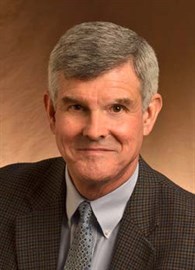 Renowned scholar Dr. George M. Pharr IV has joined the Department of Materials Science and Engineering at Texas A&M University as part of the Governor’s University Research Initiative (GURI), which is aimed at bringing the best and brightest researchers in the world to Texas.
Renowned scholar Dr. George M. Pharr IV has joined the Department of Materials Science and Engineering at Texas A&M University as part of the Governor’s University Research Initiative (GURI), which is aimed at bringing the best and brightest researchers in the world to Texas.
“Dr. Pharr has pioneered the field of nanomechanical characterization of materials and has contributed to the nanotechnology revolution,” said Dr. Ibrahim Karaman, department head for the materials science and engineering department. “I consider him, and I believe many of my colleagues would agree with me, as the father of nanoindentation, a robust technique to determine mechanical behavior of materials in nanomaterials. The Oliver-Pharr formulation for nanoindentation has accelerated the mechanistic discoveries in the field of nanomaterials. He will make a significant impact in the growth of our young department by mentoring our faculty and students and guiding us to think out of the box.”
And Pharr is eager to get started making an impact. He said that along with some equipment he’s bringing from Tennessee, some nanomechanical equipment that he’s building with National Science Foundation funds and the new GURI funds, he plans to put together a research team and build state-of-the-art lab facilities in the Giesecke Engineering Research Building.
 “What attracted me to come here at this point in time is the opportunity to build a new laboratory and assemble what we need to take the next steps in this research,” he said. “We’re ordering the latest and greatest equipment to try to build up this facility in a significant way where it will be used not just by me, but by my team and people from this department and from around this campus.”
“What attracted me to come here at this point in time is the opportunity to build a new laboratory and assemble what we need to take the next steps in this research,” he said. “We’re ordering the latest and greatest equipment to try to build up this facility in a significant way where it will be used not just by me, but by my team and people from this department and from around this campus.”
Pharr anticipates working with many researchers, from department-level collaborations to broader university-level ones. Already he’s talked to researchers in aerospace, mechanical, chemical and even the geology department.
“I’ve talked to a lot of people in a lot of departments who use these techniques that I’ve developed. They’re anxious to start collaborating, and I’m anxious to collaborate with them,” he said. “There’s a group of geologists that’s very interested in this too. They’re trying to understand what causes earthquakes, and they’re now thinking that the basic events that trigger an earthquake occur at the nanomechanical scale, so our techniques may allow them to probe the behavior of geological material from the earth’s crust and how they deform and fail at the micron scale.
“There’s also great potential for collaboration in the materials science department,” he said. “This is a new department, which is also what’s exciting about moving here. In this department, there is a strong contingency of people that do research in the area of mechanical behavior strength of materials, mostly at the macro scale; they’re natural collaborators with me. Hopefully five years from now people will say the best place in the world to (study small scale mechanical behavior) is Texas A&M University.”
Pharr, a Texas A&M Engineering Experiment Station (TEES) Distinguished Research Professor, was previously Chancellor’s Professor and McKamey Professor of Engineering at the University of Tennessee, and held a joint faculty position in the Materials Science and Technology Division at the Oak Ridge National Laboratory. He became a member of the prestigious National Academy of Engineering in 2014.
Enacted in 2015 by the 84th Legislature, GURI is a grant-matching program that assists eligible institutions of higher education in the recruitment of distinguished researchers. Last year, Governor Greg Abbott announced the recruitment of 10 distinguished researchers to Texas. Pharr was among five of the faculty who joined Texas A&M (four in the college of engineering). The grant awarded to Texas A&M totaled more than $20 million.